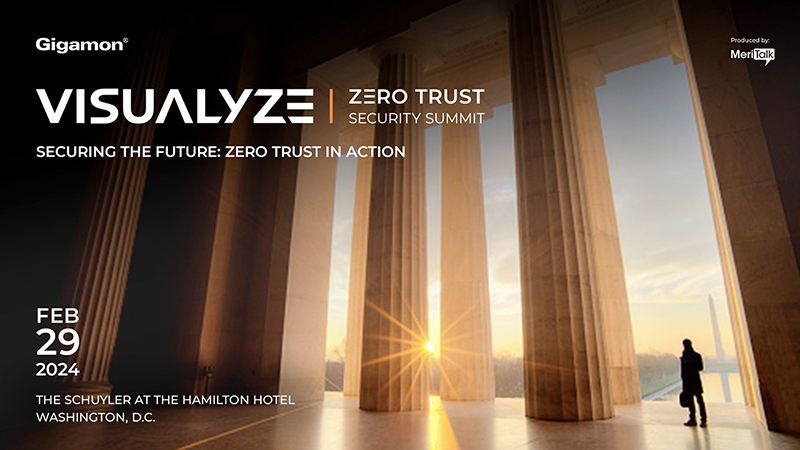
It’s been two years since the White House sent marching orders to agencies on implementing key zero trust security initiatives. Join MeriTalk and Gigamon on Feb. 29 in Washington, D.C. for a holistic look at the government’s progress and how to secure the future of government.
The Visualyze Zero Trust Security Summit promises to be an immersive summit on achieving a secure future by architecting a zero trust foundation. We will present policy best practices, security successes, practical applications, lessons learned, and next steps on the journey toward zero trust.
The Office of Management and Budget’s Federal Zero Trust Strategy turned two years old in January – where are Federal agencies in their journey today and where do they need to go?
The Pentagon issued a department-wide zero trust strategy in 2022, which gives defense agencies a deadline of fiscal year 2027 to fully implement zero trust. The military service branches are dedicated to reaching that goal on time and have begun to integrate zero trust technology successfully at the tactical edge.
“We are committed to get there by ‘27 because that’s not a department set objective – that’s an adversary response objective, so we can’t really afford to have it slip,” the Defense Department’s (DoD) Deputy Principal Chief Information Officer (CIO) Leslie Beavers said.
On the AI front, one Cybersecurity and Infrastructure Security Agency (CISA) official warned that agencies must accelerate their efforts to implement key zero trust security measures in order to keep up with potential cybersecurity threats resulting from the ongoing development of AI.
“If your agency is inching towards zero trust now, you probably want to look at accelerating that greatly to try to best keep up with the pace at which AI can start influencing,” said Ken Bailey, acting deputy branch chief of cyber defense coordination and threat hunting at CISA.
Elsewhere in the Federal government, the National Archives and Records Administration (NARA) – as the primary agency for storing and maintaining government documents – is looking to take a “balanced” approach in implementing zero trust measures across the organization.
“We’re really looking to utilize our existing resources and look at where we can improve access to information while ensuring that we are protecting all of the information,” said NARA’s Deputy CIO Nicole Willis.
Here’s the opportunity on Feb. 29 at the Visualyze Zero Trust Security Summit: join government and private sector experts who are working on this ongoing zero trust journey in real time and claim your seat at the table in the larger process.
In return, you’ll hear the latest on zero trust architecture developments and deployments from an extensive lineup of experts including:
- Randy Resnick of the DoD;
- Melinda Rogers of the Department of Justice (pending approval);
- Lauren Boas Hayes of CISA;
- Conrad Bovell of the Department of Health and Human Services;
- Beth Capello of the Department of Homeland Security (invited);
- Guy Cavallo of the Office of Personnel Management;
- Sean Connelly of CISA;
- Heather Dyer of the United States Postal Service;
- Vu Nguyen of the Department of Justice;
- Juan Torres, National Renewable Energy Laboratory;
- Laurie Ludwig, Customs and Border Protection;
- Mark Stanley of NASA; and
- Zach Tudor of the Idaho National Laboratory.
Please join us on Feb. 29 by reserving your seat at the Gigamon Visualyze: Zero Trust Security Summit.
